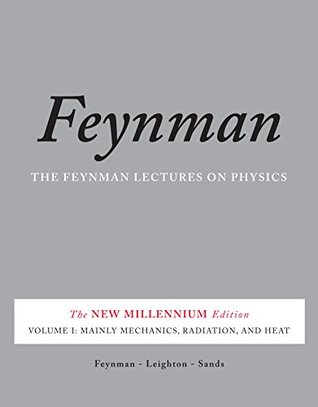More on this book
Kindle Notes & Highlights
Read between
November 15, 2015 - February 4, 2021
so we have the remarkable theorem that the rate of change of the total angular momentum about any axis is equal to the external torque about that axis!
This theorem is true for any collection of objects, whether they form a rigid body or not.
the law of conservation of angular momentum: if no external torques act upon a system of particles, the angular momentum remains constant.
Equations (18.21) and (18.22) say that a body has inertia for turning which depends, not just on the masses, but on how far away they are from the axis.
Center of Mass; Moment of Inertia
Properties of the center of mass
Thus the theorem that torque equals the rate of change of angular momentum is true in two general cases: (1) a fixed axis in inertial space, (2) an axis through the center of mass, even though the object may be accelerating.
Locating the center of mass
Finding the moment of inertia
Rotational kinetic energy
Rotation in space
Torques in three dimensions
The rotation equations using cross products
The gyroscope
However, this is a mathematical thing which, in a sense, appears as a “miracle.” It will turn out, as we go to more and more advanced physics, that many simple things can be deduced mathematically more rapidly than they can be really understood in a fundamental or simple sense. This is a strange characteristic, and as we get into more and more advanced work there are circumstances in which mathematics will produce results which no one has really been able to understand in any direct fashion.
Angular momentum of a solid body
The main effect is that, in general, the angular momentum of a rigid body is not necessarily in the same direction as the angular velocity.
Any rigid body, even an irregular one like a potato, possesses three mutually perpendicular axes through the CM, such that the moment of inertia about one of these axes has the greatest possible value for any axis through the CM, the moment of inertia about another of the axes has the minimum possible value, and the moment of inertia about the third axis is intermediate between these two (or equal to one of them). These axes are called the principal axes of the body, and they have the important property that if the body is rotating about one of them, its angular momentum is in the same
...more
The Harmonic Oscillator
Linear differential equations
The harmonic oscillator
Perhaps the simplest mechanical system whose motion follows a linear differential equation with constant coefficients is a mass on a spring: first the spring stretches to balance the gravity; once it is balanced, we then discuss the vertical displacement of the mass from its equilibrium position (Fig. 21–1).
Harmonic motion and circular motion
Initial conditions
Forced oscillations
Algebra
Addition and multiplication
Now you may ask, “What is mathematics doing in a physics lecture?” We have several possible excuses: first, of course, mathematics is an important tool, but that would only excuse us for giving the formula in two minutes. On the other hand, in theoretical physics we discover that all our laws can be written in mathematical form; and that this has a certain simplicity and beauty about it. So, ultimately, in order to understand nature it may be necessary to have a deeper understanding of mathematical relationships. But the real reason is that the subject is enjoyable, and although we humans cut
...more
The inverse operations
Abstraction and generalization
Approximating irrational numbers
Complex numbers
Imaginary exponents
This is our jewel.
This, then, is the unification of algebra and geometry.
Resonance
Complex numbers and harmonic motion
We must emphasize, however, that this separation into a real part and an imaginary part is not valid in general, but is valid only for equations which are linear, that is, for equations in which appears in every term only in the first power or the zeroth power.
The forced oscillator with damping
Electrical resonance
The difficulties of science are to a large extent the difficulties of notations, the units, and all the other artificialities which are invented by man, not by nature.)
Resonance in nature
In the second chapter, this point is made about the particles, but when the second chapter was written this resonance was not known, so our chart should now have still another particle in it!
Transients
The energy of an oscillator
The oscillator can have a great deal of energy if the friction is very low, and even though it is oscillating strongly, not much energy is being lost. The efficiency of an oscillator can be measured by how much energy is stored, compared with how much work the force does per oscillation.
Damped oscillations
Electrical transients
Linear Systems and Review


